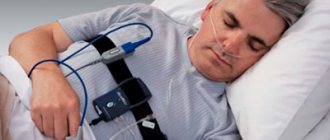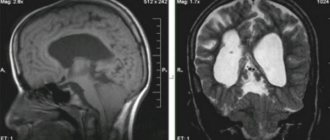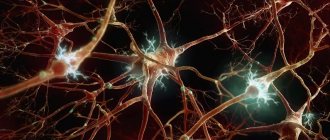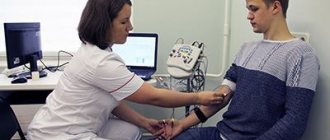Find out more about other diseases starting with the letter “C”: Compression of the brain; Senile chorea; Sensitive ataxia; Serous meningitis; "Rigid person" syndrome; Alien hand syndrome; Restless legs syndrome; Bogorad syndrome; West syndrome; Gaye-Wernicke syndrome; Guillain-Barre syndrome; Piriformis syndrome; Carpal tunnel syndrome; Carotid sinus syndrome; Kleine-Levin syndrome; Klippel-Feil syndrome; Cauda equina syndrome; Crumpy syndrome; Lambert-Eaton syndrome; Landau-Kleffner syndrome.
Crampy syndrome is paroxysmal painful contractions of individual muscles or muscle groups, characterized by a short duration and involuntary occurrence. They occur at night and are essentially cramps of the calf muscles. The duration of the attack varies from several seconds to minutes.
The diagnosis can be established after electromyography, laboratory and instrumental examinations, taking into account clinical manifestations. Treatment is aimed at eliminating the pathogenetic mechanisms and symptoms of the disease.
general information
Cramp syndrome (from the English cramp - cramp) is a very common pathological condition that is observed in almost 90% of people on our planet. One theory of the occurrence of the disease is related to the fact that most of the population is engaged in work with significant physical exertion or sedentary activities.
The age group corresponds to the 65+ category, but the syndrome can be observed among all categories. The rarest cases of convulsive seizures are recorded among children of preschool and primary school age. Men and women are equally susceptible to the disease.
Hand cramps
Convulsive contractions in the hands can be classified as an occupational disease, since they most often affect office workers who spend a lot of time at the computer, athletes, tailors, musicians, etc. However, doctors also name other reasons that can cause them:
- disorders of blood circulation in the upper extremities due to problems with the cardiovascular system or osteochondrosis;
- stress;
- excessive coffee consumption;
- alcohol or food poisoning;
- hypothermia of the skin of the hands.
Most often, hand cramps appear in one hand, so if they occur with your healthy hand, massage the spasmodic one. Clench and unclench your fist, rub your fingers from the base, tense and relax your fingers, vigorously rotate your brush.
For those people who experience muscle spasms periodically, doctors recommend drinking linden or chamomile tea, it can relax the muscles, or rubbing the areas prone to cramps with lemon juice twice a day for 2 weeks. If cramps begin to appear very often, then you need to consult a specialist to determine the true causes of the spasms and select medications.
Reasons for development
Several reasons always contribute to the formation of crampy syndrome. It can be a form of the body’s reaction to external stimuli, an independent disease, or one of the signs of certain somatic disorders. In medicine, the following factors have been identified that cause the development of painful spasms:
- Idiopathic. The occurrence of convulsive attacks does not have a specific cause. Occur from 1 time per day to 3 episodes per week, regardless of physical activity, even in a quiet position. Idiopathic cramps can be hereditary in nature - and their extreme stability is noted.
- Physical. Skeletal muscles can normally react by contracting to high or low temperatures, dehydration, physical exhaustion of the body, significant stress, and a large amount of salt in the diet.
- Somatic. Crampy syndrome is part of a symptom complex in liver cirrhosis and renal failure. Hormonal disorders, water-electrolyte imbalance in endocrine diseases also contribute to the development of convulsive attacks. Quite rarely, the crampi mechanism is triggered by paraneoplastic syndrome, glycogenosis.
- Medication. Involuntary seizures can be caused by an overdose or a side effect of certain medications. This most often occurs with the use of diuretics, statins, calcium channel blockers, and β-blockers. Acetylcholinesterase inhibitors and steroid hormones cause convulsive reactions less frequently. Cramps can result from treatment with antibiotics, psychotropic, and nootropic drugs.
- Neurological. Muscle spasms may indicate the development of Parkinson's syndrome, multiple sclerosis, atrophic lateral sclerosis, Charcot-Marie-Tooth disease and other diseases accompanied by high muscle tone and involuntary muscle activity. Injuries to nerve fibers, spinal nerve roots, osteochondrosis, poly-, mononeuropathy can also trigger the onset of the disease.
Set of measures
In order for the spasm to stop, doctors advise to massage the muscle with which the spasm occurred. The essence of the massage is to make the antagonist muscles work. By “turning on” they will stop the spasm.
If a cramp occurs while lying on the bed, you should get up and walk on the cold floor for a few minutes.
It is also recommended to eliminate provoking factors. For example, if it is noticed that a cramp occurs after certain exercises in the gym, then it is better to completely eliminate such exercises.
To relieve and reduce cramps, among other things, therapeutic exercises, contrast showers, and so-called physiotherapy are used.
Treatment of neurological causes
As mentioned above, crampy is a sign of many neurological diseases, including such serious ones as amyotrophic lateral sclerosis. With this disease, the motor neuron is affected and it is unlikely that it will be possible to stop seizures using the methods listed above.
Here you need quite powerful medications - Baclofen, Diazepam, etc. Of course, they can only be taken strictly as prescribed by a neurologist.
Let's take another similar example. Cramps become a common occurrence with complications of lumbar osteochondrosis. Consequently, all the methods and medicines that are traditionally used in the fight against this very osteochondrosis become good.
Pathogenesis
Some neurologists adhere to the theory of the development of crampy syndrome due to a deficiency of vitamins D, group B and electrolytes. High excitability of nerve endings causes contraction of skeletal muscles. An attack of irritation of the cells of the anterior horns of the spinal cord causes increased muscle contractions with a frequency of up to 300 times per second, which does not correspond to physiological indicators.
It is believed that the formation of neurogenic spasms is influenced by the presence of constant membrane currents entering the neurons of the brain. The whole process takes place with the participation of an inhibitory neurotransmitter - gamma-aminobutyric acid. This phenomenon enhances impulses along the descending pathway and spreads irritation of the motor cells of the spinal cord. Clinical research shows that in myocytes at the time of spasms, a disorder of sodium, potassium, and chloride channels occurs, and the amino acid balance is disturbed.
The nerve endings found in muscle fibers are also susceptible to external irritants, which can cause muscle spasms. Changes in water-salt balance and mechanical stimuli can cause muscle cramps.
How to help
First aid for the syndrome is provided on the spot. The patient lies on a hard surface, put a pillow or blanket under his head, and be sure to turn it on his side. During an attack, you cannot restrain a person, since this way he can get fractures - you just need to monitor your breathing and pulse. It is also necessary to call an ambulance and be sure to hospitalize this person.
In the hospital, if the attack recurs, it is stopped with the help of medications. This is basically a 0.5% solution of seduxen or relanium, which is administered intravenously in an amount of 2 ml. If everything happens again, then these drugs are reintroduced. If the status persists after the third administration, then a 1% sodium thiopental solution is administered.
Treatment of convulsive syndrome in adults is carried out after the seizure has been eliminated
It is important to understand what caused the seizures and to treat the cause itself.
So, for example, if it is a tumor, then surgery is performed to remove it. If it is epilepsy, then you should regularly take appropriate medications that help prevent the development of seizures. If this is alcohol intake, then treatment in specialized clinics is necessary. If these are head injuries, then you should be under constant supervision of a neurologist.
To find out exactly why this condition occurs, it is necessary to undergo a thorough investigation, which will include blood and urine tests, brain examination, MRI or CT scan. Special diagnostic measures may also be recommended, which are carried out if a particular disease is suspected.
It also happens that such a condition occurs only once in a lifetime, for example, against the background of high fever, infectious disease, poisoning, or metabolic disorder. In this case, no special treatment is required and after eliminating the main cause, this no longer happens.
But with epilepsy, seizures are very common. This means that a person must constantly be under medical supervision and be sure to follow all the doctor’s orders, since intractable status epilepticus may develop, which can be very, very difficult to cope with.
Clinical picture
The initial symptoms of Crampy syndrome appear in the patient's legs, most often in the legs and feet. Painful spontaneous flexion of the sole occurs. If a person begins to forcibly straighten the foot, perform self-massage, or walk with emphasis on the sore leg, the pain decreases. One attack can last from 2-5 seconds to 2-3 minutes. In severe forms of Crampy syndrome, cramps spread to all skeletal muscles. Intense spasms occur with any movement.
Most often, an attack occurs during night sleep. Physiological types have virtually no effect on the human condition and do not cause awakening. Pathological forms (Parkinson's disease) cause decreased sleep quality and insomnia. Muscle twitching in the area of convulsions may be a warning sign of an approaching attack. A prolonged pathological condition leads to local muscle hypertrophy. For 1-2 days after a series of episodes, increased susceptibility to various kinds of touches and moderate pain persist, which intensifies with movement.
Secondary forms of Crumpy may have peculiarities of their course. Prolonged cramps of several muscles at once indicate polyneuropathy. In mononeuropathies, convulsive attacks are limited, are formed by compression of nerve fibers and have residual effects after its elimination. Generalized muscle spasms are observed when the spinal cord is compressed due to curvature or narrowing of the spinal lumen.
Literature
- Beetz A. et al. Psychosocial and psychophysiological effects of human-animal interactions: the possible role of oxytocin //Frontiers in psychology. – 2012. – T. 3.
- de Carvalho M., Swash M. Origin of fasciculations in amyotrophic lateral sclerosis and benign fasciculation syndrome //JAMA neurology. – 2013. – T. 70. – No. 12. – pp. 1562-1565.
- Filippakis A. et al. A Prospective Study of Benign Fasciculation Syndrome (S45.007). – 2021.
- Foster JA, Neufeld KAMV Gut–brain axis: how the microbiome influences anxiety and depression //Trends in neurosciences. – 2013. – T. 36. – No. 5. – pp. 305-312.
- Hoge EA et al. The effect of mindfulness disorder meditation training on biological acute stress responses in generalized anxiety //Psychiatry Research. – 2021.
- Thoma MV et al. The effect of music on the human stress response //PloS one. – 2013. – T. 8. – No. 8. – P. e70156.
Diagnostics
The conclusion about the presence of Crampy syndrome is established on the basis of symptoms and the results of diagnostic studies. Differential diagnostic measures are designed to exclude the presence of restless legs syndrome, muscle contractures, titania, dystonia and other diseases. It is important for the doctor to find out the presence of the cause that forms the secondary crampi syndrome. It is important to follow all diagnostic rules:
- Collecting anamnesis, studying patient complaints. During the conversation, the presence of concomitant pathologies is established, complaints are clarified, and information about taking medications appears. Family history helps determine whether blood relatives have symptoms of the disease.
- Physical examination. Areas susceptible to convulsive attacks are examined, the presence of hypertrophic changes, increased tone, and muscle twitching is revealed.
- Laboratory diagnostics. It is mandatory to study general urine and blood tests, determine the amount of glucose in the blood, CPK, liver tests, urea and creatinine levels, analysis of protein composition and water-electrolyte balance. Lack of potassium, magnesium, potassium, surges in parathyroid hormone, T3, T4 indicate the presence of Crampy syndrome.
- Electroneuromyography. If involuntary muscle activity is recorded from 50 to 150 Hz, the seizures are said to be neurogenic. “Mute cramps”, in which there is no muscle activity, indicate a metabolic disorder.
Additional hardware research. CT, MRI of the spine, ultrasound of the vessels of the legs help to establish primary diseases and carry out adequate differential diagnosis.
Drug therapy
When crampy syndrome bothers you regularly, it is recommended to use mineral and vitamin complexes to saturate the body with useful substances. But first you should consult your doctor, informing him about all the medications you are currently taking. The most popular medications for painful cramps containing magnesium and calcium are Asparkam and Panangin.
Crampy syndrome causes, symptoms and treatment of which are aimed at eliminating spasm, in some situations requires more serious measures. If a person suffers from a chronic disease, for example, diabetic polyneuropathy, then he needs complex treatment. In this case, alpha-lipoic acid drugs are prescribed to restore the affected nerves.
Treatment of Crampy syndrome
Most often, the patient does not need hospitalization and undergoes outpatient treatment. For idiopathic forms of Crampy, physical activity is advisable, which includes passive muscle stretching, massage, and contraction of antagonist muscles. Depending on the course of the disease, the following is prescribed:
- Pathogenetic treatment. Quinine, calcium channel blockers, and antiepileptic drugs are prescribed to reduce the cyclic activity of the central nervous system. To restore water-electrolyte balance, solutions of potassium, calcium, and magnesium are administered intravenously. For endocrinological diseases, hormone replacement treatment is prescribed.
- Symptomatic therapy. Taking muscle relaxants is aimed at eliminating and preventing convulsive attacks. Nonsteroidal anti-inflammatory drugs reduce pain. Sleeping pills may be prescribed.
Features of seizures in epilepsy
But the main disease that is first remembered when considering a convulsive symptom is epilepsy. The cause of any form of seizure in this disease is abnormally increased activity of electrical impulses in the neurons of the brain of the head.
As a rule, epilepsy is accompanied by clonic-tonic generalized convulsive contractions. A sick person, as a rule, anticipates their onset thanks to the so-called aura - a special state before a seizure, which is characterized by a feeling of an unusual taste in the mouth, a heightened perception of smells, sounds, a feeling of anxiety, fear.
Most often, after this, the person loses consciousness, in some cases managing to make a sound similar to a howl or a rather loud scream. Then a strong tonic overstrain forms in all his muscles, his face turns blue, breathing becomes very difficult, his jaw clenches and convulsive seizures begin. Moreover, foam comes out of the person’s mouth, and involuntary urination may occur.
After a certain time, the face takes on a natural color, breathing is restored, convulsive movements appear less and less and disappear over time. This attack lasts no more than a few minutes. After the attack is over, a clouded state of consciousness is likely. Then most often sleep comes. Waking up from sleep, a person does not remember anything that happened to him.
Forecast and prevention of crampy syndrome
The course and prognosis of the disease are related to the cause of its occurrence. Eliminating the root cause in the secondary form of crampy allows you to completely get rid of convulsive attacks. Longer treatment is required for familial and idiopathic forms of the disease. Stretching your calf muscles and hamstring muscles before going to bed is a must.
The patient's condition is positively affected by hydrotherapy procedures, a selected set of physical activities, and cycling. The patient needs to increase daily activity, stop smoking, reduce or stop taking alcoholic and caffeine-containing drinks. When preparing for a night's sleep, you should take into account physiological needs, use a comfortable bed, and minimize external influences.
How to get rid of painful cramps
Crampy syndrome, the treatment of which is aimed at restoring the functioning of muscles that act as antagonists of spasm, is not considered a pathology. This phenomenon is most likely a feature of the tissues of the human body.
When a painful cramp appears, you should pull your foot upward with all your might, while keeping your knee straight. In this way, it will be possible to stretch a muscle that is seized by a sudden spasm. With this technique you can get rid of severe pain. Some people with crampy syndrome are helped by pressing their feet firmly on the floor surface. But the first method is considered more effective.
You can eliminate involuntary muscle contractions using other methods:
- walking on your heels for 2-3 minutes;
- a hot foot bath or shower, the duration of warming the affected muscle should be at least 5 minutes;
- walking with high legs;
- massage using ice cubes.
Main signs of the disease
Crampy syndrome is not a disease; most likely, it is a phenomenon that manifests itself even in a healthy person. In most cases, it affects the lower extremities, especially the quadriceps femoris.
Symptoms and treatment of Crampy syndrome are aimed at alleviating the patient’s condition. During an involuntary spasm, the muscle becomes hard, very painful and tense. Women carrying a baby regularly experience such unpleasant sensations at night. To alleviate the condition, you should massage the sore spot and engage in passive stretching of pinched tissues.
Attacks most often occur in a horizontal position at night, as well as after physical exertion. Under such conditions, the tissue is capable of intense and rapid contraction. The occurrence of cramps is caused by the fact that the antagonist muscles do not provide resistance. To activate their work, you just need to change your body position. For example, getting out of bed, leaning on a sore limb. Sometimes such attacks occur in the diaphragm or chest. In this case, lung and heart diseases may develop.
What to do when your leg muscles contract?
Naturally, when you have constant tonic contractions, you should definitely consult a doctor to determine their causes and conduct a full examination. You can try to relieve short-term cramps yourself.
Thus, when this unpleasant manifestation bothers your lower limbs, you must:
- place your feet on the cold floor and walk barefoot;
- pull the toe of the straightened leg towards you;
- if there are no contraindications, then you can take Aspirin (these tablets increase blood microcirculation in the vessels of the legs);
- perform self-massage of the foot - from the toes to the calf, or heel - up from the heel, to the knee;
- Apply warming ointment to this area.
A homemade ointment for muscle contractions can also help in this case. It is made from 1 tsp. olive oil and 2 tsp. mustard. This ointment is rubbed on the suffering muscles, and relief comes almost instantly.










